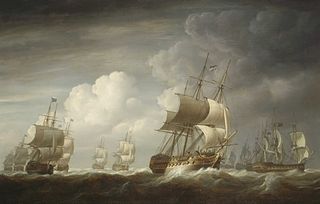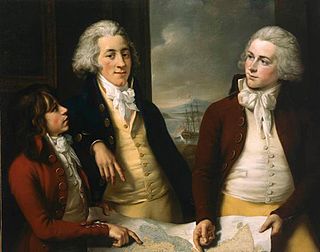Airly Castle, was built by William Barnard at Deptford and launched in 1787. She made eight voyages as an East Indiaman for the British East India Company (EIC) between 1788 and 1808. In 1795 she participated in the capture of seven Dutch East Indiamen near St Helena. After her eight voyages she may have served briefly as a general transport before she was sold for breaking up in 1810. She was not broken up but instead served as a transport for several years.
Bengal was launched in 1799 as an East Indiaman for the British East India Company (EIC). She made four complete voyages but foundered in 1809 with no trace while homeward bound from the fifth.
Huddart was launched in 1803 as an East Indiaman. She made eight voyages for the British East India Company (EIC), between 1803 and 1818. In 1810-1811 she participated as a transport in two British military campaigns. In 1818 new owners deployed her in sailing to Canada. She was wrecked there in 1821.
Hugh Inglis was launched in 1799 as an East Indiaman. She made seven voyages for the British East India Company (EIC), between 1800 and 1817. In 1810 and 1811 she participated as a transport in two British military campaigns. She was sold for breaking up in 1817.
City of London was launched in 1800 as an East Indiaman. She made six voyages for the British East India Company (EIC) between 1800 and 1814 when she was taken up as a troopship for one voyage. She made one more voyage to India under a license from the EIC and then was broken up circa 1817.
Sir Stephen Lushington was launched in 1796 as an East Indiaman. She made seven voyages for the British East India Company (EIC). During this period she took part as a transport in two military campaigns, the cancelled attack on Manila in 1797, and the capture of Mauritius in 1810. In 1812 she became a West Indiaman, thought around 1816 she made another voyage to India. Thereafter her ownership and trade becomes ambiguous: she either traded with Spain until 1822, or with South America until 1825.

Lord Hawkesbury was launched in 1787 as an East Indiaman for the British East India Company (EIC). She made eight voyages for the EIC before she was sold in 1808 for breaking up.
Dublin was launched in 1784 as an East Indiaman. She made six voyages for the British East India Company (EIC), to India and China. On her last voyage for the EIC she recaptured a country ship. Her owners sold Dublin in 1800 and she became a West Indiaman, but apparently was lost on her first voyage.

Rose was launched in 1786 as an East Indiaman. She made six voyages between 1787 and 1800 for the British East India Company (EIC). She also participated as a transport for a military expedition to the West Indies. She then made one more voyage for the EIC, bringing rice back to England from Bengal. Next she sailed as a general trader, but also made one voyage seal hunting. She was last listed in 1820.
Manship was launched in 1785 as an East Indiaman. She made six voyages as a "regular ship" for the British East India Company (EIC). In June 1795 Manship shared with several other Indiamen and the Royal Navy in the capture of eight Dutch East Indiamen off St Helena. Her owners sold her in 1801 and she then made one voyage for the EIC as an "extra ship" on a voyage charter. Her owners sold her to the British government in 1803 for use as a powder hulk.
Calcutta was launched in 1798 as an East Indiaman. She made four voyages for the British East India Company (EIC), and disappeared while homeward bound from Bengal on her fifth voyage.
Lady Jane Dundas was launched in 1800 as an East Indiaman. She made four voyages for the British East India Company (EIC) and was lost in 1809 on the homeward-bound leg of her fifth voyage. She and three other Indiamen parted from the homeward-bound convoy during a gale on 18 March 1809 and were never seen again.
General Stuart was launched in 1801 as an East Indiaman. She made seven voyages as an "extra ship" for the British East India Company (EIC) between 1801 and 1814. She then sailed between England and India under a license from the EIC. In 1819 she transported convicts from England to New South Wales. She continued to trade with Australia and was last listed in 1825.
Lady Burges was launched in 1799 as an East Indiaman. She made three voyages for the British East India Company (EIC) between 1800 and 1805. She was wrecked in 1806 early in her fourth voyage.
Worcester was launched in 1785 as an East Indiaman for the British East India Company (EIC). She made eight voyages to India and China for the EIC and participated as a transport in two naval expeditions before she was sold in 1809 for breaking up.
Walpole was launched in 1798 as an East Indiaman. She made four complete voyages for the British East India Company (EIC). She was wrecked in 1808 as she was returning to London from her fifth voyage.
Sovereign was launched at Rotherhithe in 1800 as a West Indiaman. The British East India Company (EIC) then took her up as an "extra" ship on several contracts; in all she made seven voyages as an East Indiaman for the EIC. After she left the EIC's service in 1817 she continued to trade with India, but under a license from the EIC. She was broken up in 1822.
Walthamstow was launched in December 1799 in Rotherhithe. She made six voyages for the British East India Company (EIC). She was sold in 1814 for breaking up.
Devaynes was launched in 1802 and made six voyages as an East Indiaman for the British East India Company (EIC). She then made one more round-trip to India, sailing under a license from the EIC. She was condemned at Bengal in 1817 on a second licensed voyage to Bengal.
Lord Duncan was launched on the River Thames in 1798 as an East Indiaman. She made seven voyages for the British East India Company (EIC) before she was sold in 1813 for breaking up.

